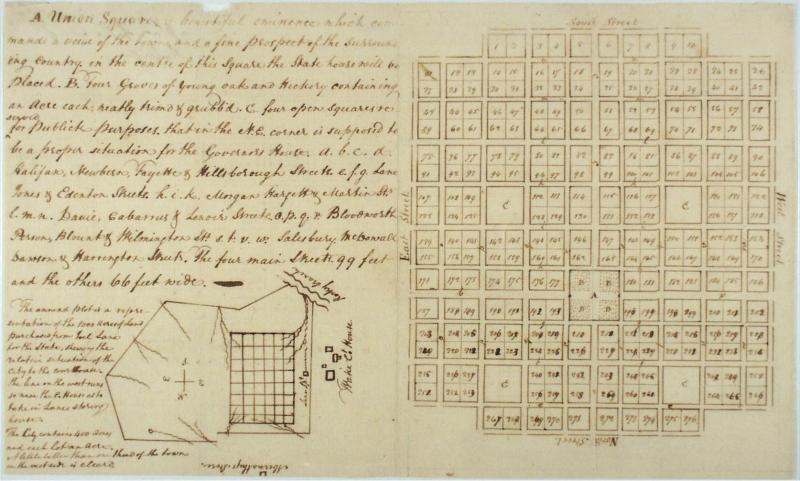William Christmas' plan for Raleigh, 1792
A. Union Square a beautiful eminence which com-mands a view of the town, and a fine prospect of the surround-ing country in the centre of this Square the State house will be placed. B. Four Groves of young oak and Hickory containing an Acre each neatly trimd [sic] & grubbd [sic]. C. four open square re-served for Publick Purposes that in the N.E. corner is supposed to be a proper situation for the Governors House. a.b.c.d. Halifax, Newbern, Fayette [sic] & Hillsborough Streets. e.f.g. Lane Jones & Edenton Streets. h.i.k. Morgan Hargett & Martin Sts. l.m.n. Davie, Cabarrus & Lenoir Streets. o.p.q.r. Bloodworth, Person, Blount & Wilmington Sts. s.t.v.w. Salisbury, McDowall [sic] Dawson & Harrington Streets. The four main Streets. 99 feet and the others 66 feet wide. The annexd [sic] plot is a repre-sentation of the 1000 Acres of Land purchased from Joel Lane for the State, showing the relative situation of the city to the court house. The line on the west [MS. illegible] so near the Co. House as to take in Lanes storing house. The City contains 400 Acres and each Lot an Acre. A little better than one third of the town on the west side is cleard [sic]

Christmas, William. Plan of Raleigh, 1792. North Carolina Digital Collections. State Archives of North Carolina. Accessed April 6, 2022. https://digital.ncdcr.gov/Documents/Detail/plan-of-raleigh/418303.
Public Domain
Public Domain is a copyright term that is often used when talking about copyright for creative works. Under U.S. copyright law, individual items that are in the public domain are items that are no longer protected by copyright law. This means that you do not need to request permission to re-use, re-publish or even change a copy of the item. Items enter the public domain under U.S. copyright law for a number of reasons: the original copyright may have expired; the item was created by the U.S. Federal Government or other governmental entity that views the things it creates as in the public domain; the work was never protected by copyright for some other reason related to how it was produced (for example, it was a speech that wasn't written down or recorded); or the work doesn't have enough originality to make it eligible for copyright protection.